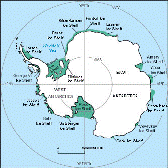Antarctic Drilling Program (ANDRILL)

ANDRILL Related Publications of Affiliates
Document Type
Article
Date of this Version
2007
Abstract
Many collections of Eocene Fossil leaves from Antarctica contain a rich store of insect trace fossils, indicating that insects were an important component of the unique forests that grew in polar regions. However, insect body fossils themselves are rare and so insect traces provide an excellent opportunity to examine both the palaeoentomology and the palaeoclimate of Antarctica. The fossils studied include Eocene leaves from both Seymour Island and King George Island on the Antarctic Peninsula. A database of all insect traces on the Antarctic fossil leaves was compiled and analysed in terms of the diversity of palaeoherbivory. The fossil leaves are diverse with several different plant species present such as Nothofagaceae and Cunoniaceae. The range of traces found includes leaf mines, galls and general leaf chewing, of which both marginal and non-marginal examples are present. The preliminary results of the comparison with modern day environments in South America will be shown, providing a greater indication of the types of insects that may have created such traces in Antarctica in the past.


Comments
Citation: McDonald, C.M., J.E. Francis. S.G.A. Compton, A. Haywood, A.C. Ashworth, L.F. Hinojosa. Herbivory in Antarctic Fossil Forests: evolutionary and palaeoclimatic significance, in Antarctica: A Keystone in a Changing World – Online Proceedings of the 10th ISAES X, edited by A.K. Cooper and C.R. Raymond et al., USGS Open-File Report 2007-1047, Extended Abstract 059, 4 p.